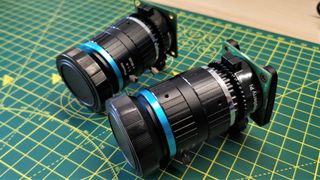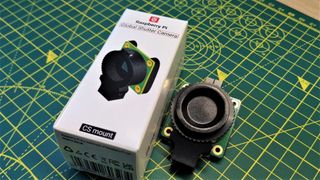Tom's Hardware Verdict
If you need to capture high speed subjects, then the Global Shutter Camera is for you. Mainstream users are best sticking with the High Quality Camera.
Pros
- +
Captures fast moving subjects with ease
- +
Same form factor as High Quality Camera
- +
Works with existing software
Cons
- -
Low megapixel count
- -
Niche
Why you can trust Tom's Hardware
Mere weeks after releasing the Raspberry Pi Camera Module v3, Raspberry Pi has released another camera and it looks just like the venerable Raspberry Pi High Quality camera that we reviewed way back in 2020.
The $50 Raspberry Pi Global Shutter Camera is not the successor to the High Quality camera; that camera is definitely still in our Best Raspberry Pi Accessories list. Instead, the Global Shutter camera is an accompaniment which offers compatibility with lenses and tripod mounts, but swaps out the rolling-shutter used in previous cameras for a faster global shutter. The new shutter captures images and video with no rolling-shutter artefacts, which makes it great for capturing fast moving objects like athletes at sports games or blades on a fan without distortion. However, you’ll have to accept lower resolution than on other Pi cameras.
Raspberry Pi Global Shutter Camera Specifications
| Header Cell - Column 0 | Global Shutter Camera | High Quality Camera |
|---|---|---|
| Sensor | Sony IMX296LQR-C | Sony IMX477 |
| Sensor Resolution | 1.6 Megapixel | 12 Megapixel |
| Max Resolution | 1440 x 1080 pixels | 4056 x 3040 |
| Shutter | Global shutter | Rolling shutter |
| Lens Compatibility | C or CS Mount | C or CS Mount |
| Dimensions | 38 × 38 × 19.8 mm | 38 × 38 × 19.8 mm |
At a casual glance the Global Shutter camera looks almost identical to the original High Quality camera. The only thing that gives it away is a plastic cover with the Raspberry Pi logo embossed upon it. The cover is there to protect the delicate surface mount electronics from harm. The Global Shutter camera takes the same C / CS lenses as the High Quality camera, which means we can mix and match our favorite lenses between the two.





Where the similarities end is at the sensor. The 1.6 megapixel Sony IMX296 sensor of the Global Shutter is no match for the Sony IMX477’s 12 megapixels. But it's not all about the pixels with this new camera.
For all past models of Raspberry Pi camera a rolling shutter has been used. The array of 2D light sensitive pixels creates a value according to the amount of light they can see. These values are then converted into something that the Raspberry Pi can then understand. The array has rows of analog-to-digital converters which will send their data to the Pi with a slight delay per row. This delay is what causes distortion on fast moving objects in a video or image. Have you ever tried to shoot video of a propeller or desk fan? Those curves that flutter into the image are what the sensor is “seeing” as the blade moves through the sensor window. For static images or low-speed video, this is fine. But when we want to record at speed, say a sports event, science experiment or machine learning, we need the clearest image possible and that is where a global shutter comes into play.
Global shutters work by assigning each pixel its own analog storage element. Triggering the shutter will dump the analog value to each pixel's storage element where it can then be read. You only get 1.6 megapixels, but this camera isn’t about resolution as much as clarity at speed.
Design of the Raspberry Pi Global Shutter Camera
Following the design of the original High Quality camera, the Global Shutter camera features the same metal tripod mount that we wish other models of Raspberry Pi camera featured. The black plastic cover protects the circuits from accidental shorts, something that wasn’t present with our High Quality camera back in 2020. The same four M2.5 screw holes are present on the corners of the PCB, meaning that we can easily encase the camera in cases designed for the High Quality camera.
Lenses are interchangeable between the two models, meaning we can reuse the many different options that we purchased for the High Quality camera (including one that enables Canon lenses to be used). C mount lenses will need a readily available adaptor, but this is cheap and trivial to use.
Using Raspberry Pi Global Shutter Camera
The software for the Global Shutter camera is exactly the same as the recent Camera Module 3. We have libcamera and Picamera2. The former is a terminal application with remarkable features to control every aspect of the entire camera range (including setting the Camera Module 3’s focus system). The latter, Picamera2 is a Python module that replicates many of the same features and is easily integrated into Python projects.
In our tests, the Global Shutter camera has a maximum framerate of 60fps. Using the libcamera application we tried to force the camera to record at higher, but every time it ignored our parameter. The only time it changed the framerate was when we set the rate to lower than 60. The Global Shutter camera was happy to run at 30 fps. We have contacted Raspberry Pi to confirm the specifications and should there be an error we will retest.

As the Global Shutter and High Quality cameras use the same lenses and software, the key area to test is the claim of no rolling-shutter artefacts. To benchmark this, we used the same 16mm lens, at a fixed height above the test subject.
Rolling-shutter artefacts are generated by fast moving objects, for example the propeller of a plane. Our budget wouldn’t stretch to hiring a plane, so a desk fan was our only option. We removed the safety cover of the fan (don’t try that at home), giving the cameras the best possible chance of capturing the blades in motion. We set the resolution of the cameras to 1440 x 1080, the maximum supported for the Global Shutter camera’s Sony IMX296 sensor.




First we captured a video using libcamera and the High Quality camera. The rolling-shutter artefacts were clearly present. What looked like dark waves swept across the rotating blades as they span at full speed. Moving the fan (carefully) made little difference, the artefacts were there to be seen. The same test using the Global Shutter camera revealed little or no rolling-shutter artefacts. The spinning blades were still a blur, but there were no dark waves sweeping across the blades.
We then moved the test to Picamera2 and after configuring the test to use the same resolution we recorded video using both cameras. Again we saw horrible rolling-shutter artefacts with the High Quality camera and none with the Global Shutter camera.
What Projects is the Raspberry Pi Global Shutter Camera Good For?
If you need to capture fast moving images and video, then the Global Shutter camera is the one to go for. Sports, machine learning and science experiments will benefit from the speed and the interchangeable lens options means we can select the right lens to capture the subject. Machine learning projects, where quick acquisition of a subject is required, will benefit from the Global Shutter’s speed.
What the Global Shutter camera is not useful for are general photography projects. If you are capturing a slow moving or static object, then go for the High Quality camera. You’ll get a better quality image.
Bottom Line

The Global Shutter camera’s appeal is limited, but for those that need its feature set, its arrival is surely to be welcome. If you need the best possible image quality, then the High Quality camera is still hard to beat. We loved that it follows the mechanical standards used by the High Quality camera. Being able to reuse our lenses and existing tripods and armatures means we don’t need to shell out more money.
Les Pounder is an associate editor at Tom's Hardware. He is a creative technologist and for seven years has created projects to educate and inspire minds both young and old. He has worked with the Raspberry Pi Foundation to write and deliver their teacher training program "Picademy".
-
edzieba The Global Shgutter Camera is not really for fast objects or high-speed video. It's for machine vision applications. Use of a global shutter means both that metrology of non-stationary objects is possible with acceptable accuracy (e.g. objects on a moving conveyor), and with genlocking you can use multiple cameras viewing the same object or scene and ensure that all pixels will be captured over the same period of time (e.g. for volumetric tracking applications).Reply -
deesider Reply
I wonder if that would also be beneficial for a motion capture array? Certainly a lot cheaper than a bunch of iphones...edzieba said:The Global Shgutter Camera is not really for fast objects or high-speed video. It's for machine vision applications. Use of a global shutter means both that metrology of non-stationary objects is possible with acceptable accuracy (e.g. objects on a moving conveyor), and with genlocking you can use multiple cameras viewing the same object or scene and ensure that all pixels will be captured over the same period of time (e.g. for volumetric tracking applications). -
edzieba Reply
That's what I meant by 'volumetric tracking applications'.deesider said:I wonder if that would also be beneficial for a motion capture array? Certainly a lot cheaper than a bunch of iphones...

